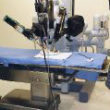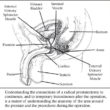Recent Published Reports Raise Concerns about Robotic Surgery for Cancer
by William J. Catalona, M.D.
Many hospitals and surgeons are committed to robotic surgery technology. In this regard, it has been claimed that 85% of the thousands of radical prostatectomies performed each year are now performed robotically. However, the FDA has never approved the robot for any type of cancer surgery, so all cancer operations performed with the robot are officially “off-label use” of the robot.
 One of my concerns is that there are very limited rigorous long-term cancer control data on robotic surgery. The most important outcome should be cancer control.
One of my concerns is that there are very limited rigorous long-term cancer control data on robotic surgery. The most important outcome should be cancer control.
Furthermore, authors have speculated that the high-pressure insufflation with carbon dioxide used to suppress bleeding (called the “pneumoperitoneum”) during robotic surgery may spread cancer cells throughout the abdomen and possibly into the lymphatic system and the bloodstream as well. This may compromise cancer cure rates, especially with aggressive, high-grade tumors.
It is also possible that robotic surgical instruments that are used for retraction and visualization during minimally-invasive surgery also may disseminate tumor cells.
Recently published research
Recent articles have raised concerns about the oncologic outcomes of robotic cancer surgery spreading cancer cells in patients with cancer of the uterine cervix, bladder, testicle, ovary, breast, and now prostate.
Uterine cervix cancer
For example, evidence reported from the MD Anderson Cancer Center in the New England Journal of Medicine (NEJM) showed increased cancer death rates for robotic radical hysterectomy for cancer of the uterine cervix. (Link to study.) The data and safety monitoring committee that had oversight for this randomized clinical trial recommended that it be permanently closed to new patient enrollment and that investigators be made aware that the minimally- invasive surgical intervention was associated with higher rates of cancer death.
It was not clear why cervical cancer outcomes were worse following minimally-invasive surgeries. The robotic surgeon at MD Anderson, Dr. Ramirez, suggested that the instruments used to manipulate the uterus during the operation may cause cancer cells to spread. Another possibility is that the carbon dioxide pumped into the abdomen during robotic and other minimally-invasive procedures to provide working and viewing space for the surgeon may increase the likelihood of cancer cells implanting, Dr. Ramirez said. Dr. Ramirez’s own department stopped performing minimally-invasive radical hysterectomies in October 2017, when the first study’s results were confirmed. “My feeling is, this is about patient care,” he said. “It’s not about how much time you devoted to your training or your ego. It’s an issue of cancer, and having a high likelihood of cancer coming back if you have surgery through this approach.”
In the same issue of the NEJM, a multi-institutional study from Harvard, Northwestern, Columbia, and the University of Wisconsin reported that the adoption of minimally-invasive surgery for cervical cancer in the United States, starting in 2006, coincided with the beginning of a decline in 4-year relative survival rates (65% lower) among women undergoing radical hysterectomy for cervical cancer. (Link to study.) These and other reports have curtailed the use of robotic hysterectomy for cervical cancer, which previously accounted for 70% of these operations in the U.S.
Bladder cancer
A randomized trial of bladder cancer from Memorial Sloan Kettering reported that patients who had robotic surgery had a higher rate of tumor recurrences inside the abdomen than those treated with open surgery. (Link to study.) Similarly, another non-randomized study from Weil-Cornell (Nguyen et al) reported that this pattern of tumor recurrences in the abdomen was not seen in patients undergoing open surgery, suggesting an increased risk for local/abdominal recurrences following robotic bladder cancer surgery. (Link to editorial.)
Testicular cancer
Indiana University reported cases of abdominal lymph node dissections for testicular cancer in which cancer cells appeared to have been spread throughout the abdomen, which is not seen with open surgery. The authors stated that this “… should serve as a word of caution with regard to the widespread implementation of robotic operative approaches for men with [testicular germ cell tumors].” (Link to study.)
Breast cancer
An editorial in Journal of the American Medical Association (JAMA) cautioned breast cancer surgeons against using the robot for breast cancer surgery until there is evidence about its safety and efficacy. The author, Julie Margenthaler, M.D. stated that the “…introduction of a new surgical instrument requires guidelines for use that protect the interests of patients, physicians, and health care systems.” She further commented, “This is a stark reminder that the marketing of robotic surgery has its roots in cosmesis and convenience rather than oncologic outcomes. This concept is attributed to Abraham Maslow who said in 1966, ‘It is tempting, if the only tool you have is a hammer, to treat everything as if it were a nail.’ I firmly believe that robotic-assisted mastectomy should only be considered in the context of a well-designed, randomized trial evaluating patient selection, patient safety, surgical complications, and oncologic outcomes with a concomitant cost analysis. Any paradigm shift in the standard of care deserves an ethical evaluation of non-inferiority. Until that time arrives, put the trocars down and step away from the robot.” (Link to editorial.)
Ovarian cancer
An observational study in JAMA Oncology found that women who had minimally-invasive surgery for ovarian cancer were more likely to have the capsule of the ovary rupture during the operation, and women with ruptured tumors were more likely receive chemotherapy and had lower survival rates. (Link to research letter.)
Prostate cancer
A recent publication from the Mayo Clinic in The Journal of Urology reported that there are prostate cancer patients treated with robotic prostatectomy who have cancer recurrences with a tumor growing out of the robot port sites and/or spread throughout the abdomen. (Link to publication.) The authors stated that, “It is likely that cases of tumor seeding and implantation may occur but remain underreported because they are not recognized (by imaging or surgical exploration) or do not affect the natural history or treatment strategies for the disease.” I have never seen it in my patients treated with open radical prostatectomy. There is prior evidence that prostate cancer cells can seed and implant directly to other tissue. Mechanisms of seeding in laparoscopic and robotic surgery are not yet clear and are likely a result of a multifactorial process including tumor- related factors (a high-grade, aggressive primary prostate tumor). One possible risk factor for tumor seeding during robotic prostatectomy is the manipulation and extraction of the specimen, causing tumor spillage. Also, carbon dioxide insufflation during the operation could be another important factor. Moreover, the upper abdominal locations of tumor recurrences may be explained by the association of the steep head-down positioning of the patient during robotic prostatectomy that increases the peritoneal fluid movement.
I believe that patients should be apprised of these concerns about robotically-assisted surgery for cancer.
-William J. Catalona, M.D.
 Background Information
Background Information
On February 28, 2019, the U.S. Food and Drug Administration issued a safety communication urging caution when using robotically-assisted surgical devices for mastectomy and other cancer related surgeries. The FDA has not granted marketing authorization for any robotically-assisted surgical devices for use in mastectomy or for the treatment or prevention of cancer. The statement came after the FDA was made aware of scientific literature and media publications reporting poor outcomes for patients, including one limited report that describes a potentially lower rate of long-term survival when surgeons and hospital systems use robotically-assisted surgical devices instead of traditional surgery for hysterectomy in cases of cervical cancer.
“We want doctors and patients to be aware of the lack of evidence of safety and effectiveness for these uses so they can make better-informed decisions about their cancer treatment and care,” said Dr. Terri Cornelison, assistant director for the health of women at the FDA’s Center for Devices and Radiological Health, in the New York Times, March 11, 2019.














